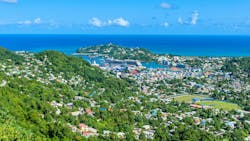Island Power and Wildfire Challenges: Navigating Reliability
We had the privilege of traveling to Hawaii’s Big Island about 13 years ago. It wasn’t a trip that we had planned; my husband’s company sent him to work on an engineering project there, so I tagged along. It was one of the best trips I have taken. The island is magical and beautiful. But as I sat on the patio overlooking the ocean, I felt a bit claustrophobic, realizing we couldn’t go very far without a plane (or a boat). That is probably the result of my having lived in the middle of the United States my entire life. I am about as landlocked as you can get.
Electricity supply and reliability on an island gives me pause when I have the obvious, anxious thought that it’s not part of a huge, interconnected grid. But I suppose being part of an interconnected grid doesn’t always guarantee reliability. It is interesting, however, to consider the challenges and characteristics unique to island power.
We have covered Hawaii and Puerto Rico quite a bit, with Hawaii’s renewable energy push and wildfire devastation, and Puerto Rico’s rebuild after multiple hurricanes. This time, we travel to St. Lucia, an island nation in the Lesser Antilles, known for beautiful white sand beaches and the Piton Mountains. But as with so many other places, the island nation is seeing more frequent and more powerful large storms. St. Lucia Electricity Services Ltd. (LUCELEC) is trying to figure out the smartest way to strengthen resilience for its transmission and distribution system. The story in this issue focuses specifically on how LUCELEC identified some easy wins, but we will also check back in with them at some point, as the island works to decrease its reliance on imported diesel fuel for generation.
Wildfire Season
It has been eight months since Hawaii’s Maui Island experienced a disastrous wildfire that killed more than 100 people and destroyed more than 2,000 acres. While the fire is still under investigation, there seems to have been a perfect storm with a moderate drought, vegetation issues, underestimated risk, and strong winds.
The prevalence of wildfires has become a pressing global concern, with electric utilities facing scrutiny regarding their role in sparking or exacerbating wildfires, infrastructure protection from wildfires, and restoration afterward. Utilities are taking this seriously and are learning about and investing in advanced technology and infrastructure upgrades to mitigate wildfire risks, including enhanced monitoring systems, vegetation management and proactive maintenance protocols. The U.S. Department of Energy (DOE) has also allocated up to $3.46 billion for 58 projects across 44 states to enhance electric grid resilience and reliability, which include projects with strategies to protect against wildfires, such as undergrounding vulnerable overhead lines, removing hazardous vegetation, installing sensors, fire-resistant poles, and improving modeling capabilities.
Southern California Edison has been a leader for the industry with its wildfire mitigation initiatives and continually shares its experiences and best practices with T&D World. On page 26, SCE iterates that it uses several layers of protection in mitigation including inspections, vegetation management, weather monitoring and public safety power shutoffs.
And be sure to read through our annual Wildfire Mitigation supplement. The supplement is a two-time winner of Best Special Issue/Supplement from the American Society of Business Press Editors and is proof that the electric utility industry is moving forward quickly in dealing with wildfires in its processes and new technologies. Senior Editor Jeff Postelwait gives an update on utility wildfire mitigation efforts in his Editor’s Letter, and you hear from Idaho Power, Salt River Project and FortisAlberta.
Storm Season
In keeping with the theme of reliability threats, we include an article this month that focuses on a renewable power source and its biggest maintenance problem: lightning strikes. Although not primarily transmission or distribution, you might be interested in learning about how wind turbine operators can make sure their lightning protection systems are installed and working correctly.
It's funny because the Department of Energy states in a fact sheet about Energy Reliability that “Renewable energy contributes to energy reliability because there are no limits to the amount of wind, solar, water, and geothermal power that Earth provides.” Of course we know it’s a little more complicated than that, and I don’t even have to go into renewable power’s intermittency, resilience, and efficiency issues. I suppose any type of power generation contributes to reliability because it produces some electricity.
Regardless, we will continue to deal with storms, wildfires, attacks, and aging in generation and in T&D, and with renewable and fossil fuel sources. As I have said before, our industry has the best and brightest people working on all these problems, and we will continue to see progress and solutions in resilience and the energy transition. I continue to be amazed at how the utilities have gone from taking weeks to rebuild infrastructure after a hurricane, to days in many cases.
T&D World also foresees a future with utilities being able to stop wildfires before or soon after they start to prevent widespread damage. They will be the ones that have active monitoring, AI, and vegetation management. Collaboration across multiple stakeholders, including firefighting agencies, communities, technology providers, policymakers, research institutions, and other utilities, will be essential.
About the Author
Nikki Chandler
Group Editorial Director, Energy
Nikki is Group Editorial Director of the Endeavor Business Media Energy group that includes T&D World, EnergyTech and Microgrid Knowledge media brands. She has 29 years of experience as an award-winning business-to-business editor, with 24 years of it covering the electric utility industry. She started out as an editorial intern with T&D World while finishing her degree, then joined Mobile Radio Technology and RF Design magazines. She returned to T&D World as an online editor in 2002. She has contributed to several publications over the past 25 years, including Waste Age, Wireless Review, Power Electronics Technology, and Arkansas Times. She graduated Phi Beta Kappa with a B.S. in journalism from the University of Kansas.

